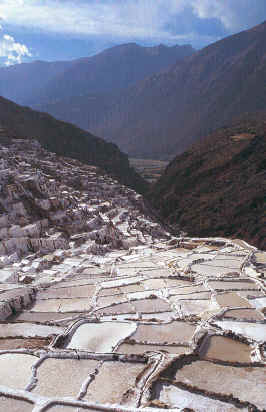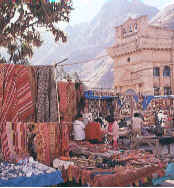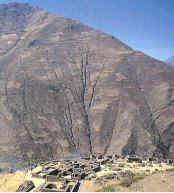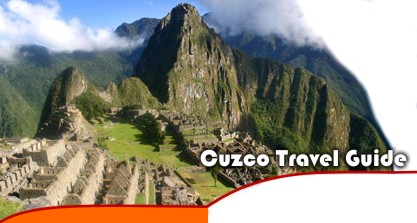|
General
Information |
|
|
|
|
|
|
|
|
|
|
|
|
|
|
|
Tip's |
|
|
|
|
|
|
|
Archeological
Sites |
|
|
|
|
|
|
|
|
|
|
|
|
|
Museums and
Traditions |
|
|
|
|
|
|
|
|
|
|
|
|
|
Churches |
|
|
|
|
|
|
|
|
|
|
|
|
|
|
|
Others
Interesting |
|
|
|
|
|
|
|
|
|
|
|
|
|
|
|
|
| |
| |
| |
| |
| |
| |
| |
| |
| |
| |
| |
| |
| |
| |
| |
| |
| |
| |
|
|
|
|

|
| |
|
SACRED VALLEY TRAVEL GUIDE |
| |
 The Sacred Valley of the Incas The Sacred Valley of the Incas
was undoubtedly a key area of settlement to the Incas. Its agreeable
climate and fertile plains make a rare and fruitful combination for
the high Andes. It was also the route to the jungle and therefore an
area with access to the fruits and plants of the tropical
lowlands.The small towns that are part of this valley are:Písac
Písac lies 33 kilometres from the city of Cuzco by a paved road, and
has an old quarter, an archaeological site considered one of the
most important in Cuzco, and a modern quarter, dating from the
colonial period. It also has a Sunday market, which attracts
thousands of visitors and people from remote communities, dressed in
colourful, traditional attire. Every Sunday there is the procession
of the varayocs, or mayors, who, at around 9:30 am, go to church to
attend the traditional Mass held in Quechua.
Chinchero
This community is located 28 km from Cuzco on the paved road to
Urubamba. Here lie the remains of what was the royal hacienda of
Túpac Inca Yupanqui, as well as a beautiful colonial temple built on
Inca foundations. Its main attraction, however, is its Sunday market,
which was originally dedicated to the barter of products by the
people of the valley and the upper areas. Nowadays, the market is a
real hub of activity, vibrant with colour and movement which
fascinates tourists with its range of handicrafts and textiles made
in true pre-Columbian style.
Ollantaytambo
A typical Inca community located 21 km from Urubamba at 2,800 masl,
named in honour of the chief Ollanta, who was famous for courting an
Inca princess, daughter of Pachacútec. One of its best-preserved
areas, known as Hanan Huacaypata lies north of the main square and
contains 15 estates built with elegantly crafted stone walls.
Ollantaytambo also features an extensive archaeological site located
on the imposing hillside overlooking the town, containing structures
such as the Temple of the Sun, and the Mańacaray or Royal Hall, the
Incahuatana and the Bańos de la Princesa. It also has hotels,
restaurants and horses and mountain bikes for hire. A branch road
leading from Ollantaytambo to the Málaga mountain pass (4,200 masl),
goes through towns such as picturesque Huílloc, home to the renowned
wayruros (porters).
Moray
Moray (3,500 masl) lies just 7 km away from Maras, although the road
to it is not always in good condition. This community is famous for
its embedded amphitheatre, formed by four circular terraces which
seem to disappear into the interior of the puna, like an artificial
crater. Evidence seems to suggest that Moray was an important centre
of Inca agricultural research on crops, which was carried out on
different sized plots located at various altitudes (some of which
were at more than 100 m underground). The Andean terraces, built on
retaining walls filled with fertile soil and watered via a complex
irrigation system, offer up more than 250 different types of
vegetables and cereals, such as corn, quinoa and kiwicha. |
|

|

|
 |
| |
| Take a look at this
Peru
Tourism Statistics |
| |
|
Package |
Kind |
Duration |
Fixed Departure
Dates |
Highlights |
|
Machu
Picchu Express 3 Days |
Cultural
Program |
3 days and 2
nights |
Daily |
Cusco and
Machu Picchu |
|
Machu
Picchu Classic 4 Days |
Cultural
Program |
4 days and 3
nights |
Daily |
Cusco, Sacred
Valley and Machu Picchu |
|
Cusco Classic Plus |
Cultural
Program |
5 days and 4
nights |
Mondays
Wednesdays
Thursdays
Saturdays |
Cusco, Sacred
Valley and two days at Machu Picchu |
|
Cusco Soft Adventure |
Soft
Adventure Program |
5 days and 4
nights |
Mondays
Wednesdays
Saturdays |
Short Inca
Trail to Machu Picchu (2 days), Cusco, Sacred Valley |
Hostal in cusco |
|
